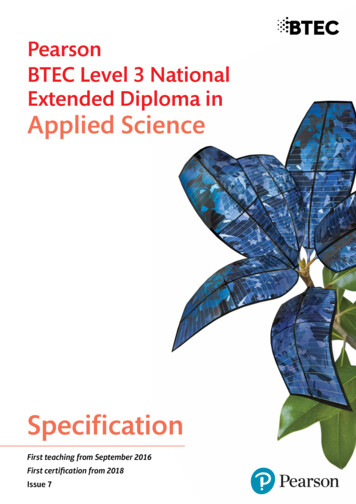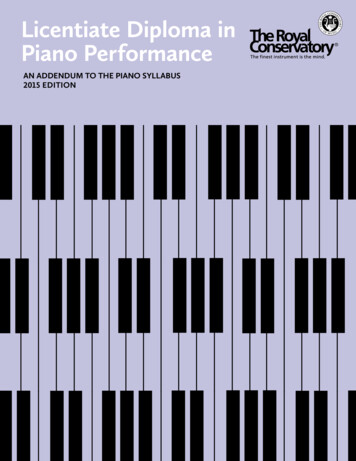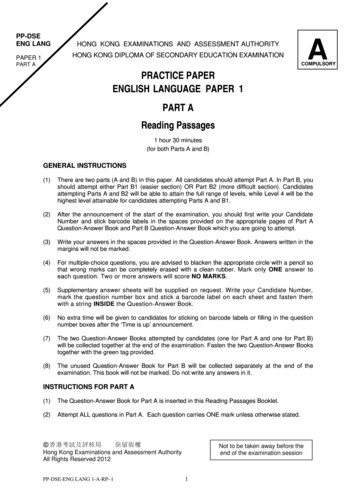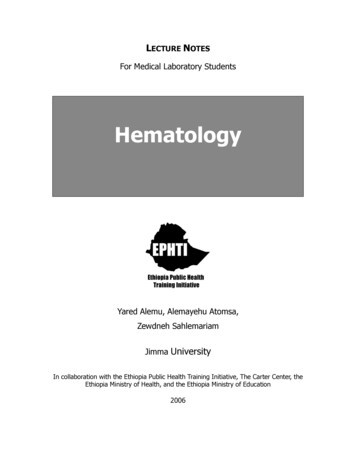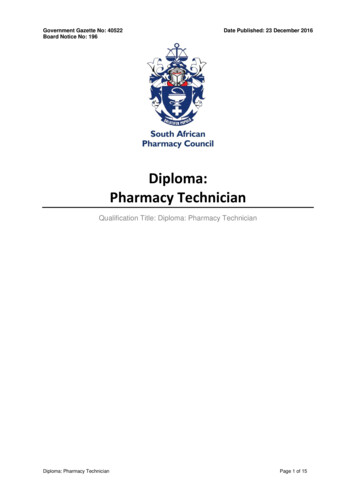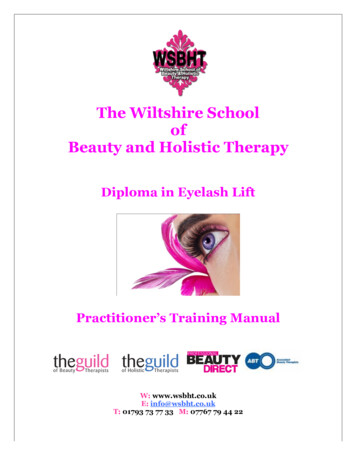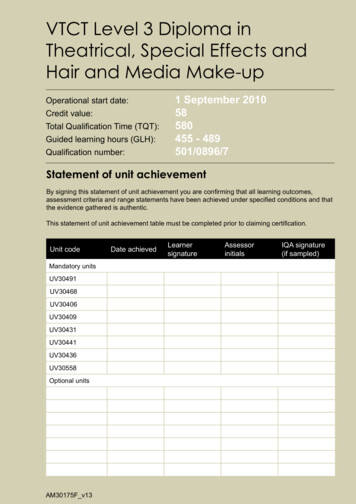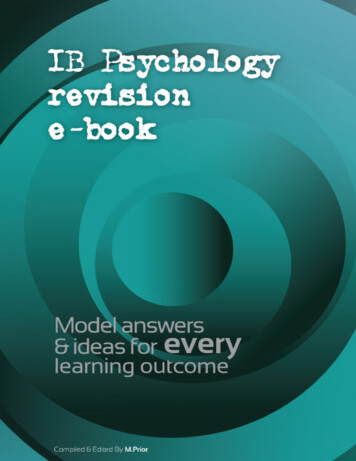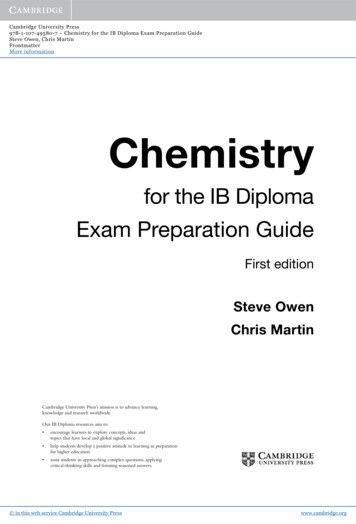
Transcription
Cambridge University Press978-1-107-49580-7 – Chemistry for the IB Diploma Exam Preparation GuideSteve Owen, Chris MartinFrontmatterMore informationChemistryfor the IB DiplomaExam Preparation GuideFirst editionSteve OwenChris MartinCambridge University Press’s mission is to advance learning,knowledge and research worldwide.Our IB Diploma resources aim to: encourage learners to explore concepts, ideas andtopics that have local and global significance help students develop a positive attitude to learning in preparationfor higher education assist students in approaching complex questions, applyingcritical-thinking skills and forming reasoned answers. in this web service Cambridge University Presswww.cambridge.org
Cambridge University Press978-1-107-49580-7 – Chemistry for the IB Diploma Exam Preparation GuideSteve Owen, Chris MartinFrontmatterMore informationUniversity Printing House, Cambridge cb2 8bs, United KingdomCambridge University Press is part of the University of Cambridge.It furthers the University’s mission by disseminating knowledge in the pursuit ofeducation, learning and research at the highest international levels of excellence.Information on this title: education.cambridge.org Cambridge University Press 2015This publication is in copyright. Subject to statutory exceptionand to the provisions of relevant collective licensing agreements,no reproduction of any part may take place without the writtenpermission of Cambridge University Press.First published 2015Printed in the United Kingdom by Latimer TrendA catalogue record for this publication is available from the British Libraryisbn 978-1-107-49580-7 PaperbackAll questions, answers and annotations have been written by the authors. In examinations,the way marks are awarded may be different.Cambridge University Press has no responsibility for the persistence or accuracyof URLs for external or third-party internet websites referred to in this publication,and does not guarantee that any content on such websites is, or will remain,accurate or appropriate. Information regarding prices, travel timetables, and otherfactual information given in this work is correct at the time of first printing butCambridge University Press does not guarantee the accuracy of such informationthereafter.notice to teachers in the ukIt is illegal to reproduce any part of this work in material form (includingphotocopying and electronic storage) except under the following circumstances:(i) where you are abiding by a licence granted to your school or institution by theCopyright Licensing Agency;(ii) where no such licence exists, or where you wish to exceed the terms of a licence,and you have gained the written permission of Cambridge University Press;(iii) where you are allowed to reproduce without permission under the provisionsof Chapter 3 of the Copyright, Designs and Patents Act 1988, which covers, forexample, the reproduction of short passages within certain types of educationalanthology and reproduction for the purposes of setting examination questions. in this web service Cambridge University Presswww.cambridge.org
Cambridge University Press978-1-107-49580-7 – Chemistry for the IB Diploma Exam Preparation GuideSteve Owen, Chris MartinFrontmatterMore informationCONTENTSIntroductionvHow to use this bookviAcknowledgementsviii1 Stoichiometricrelationships1.1 The particulate nature of matterand chemical change1.2 States of matter (solids, liquidsand gases)1.3 Balancing equations1.4 Moles1.5 Empirical and molecular formulas1.6 Using moles in calculations1.7 Solutions2 Atomic structure2.12.22.32.42.52.6The structure of atomsIsotopes and relative atomic massesElectron configurationsAtomic emission spectraAtomic spectra calculations (HL only)Ionisation energy (HL only)3 Periodicity3.1 The periodic table3.2 Variation of properties down agroup and across a period3.3 Chemical properties of elementsin the same group3.4 The transition metals (d block)(HL only)3.5 Formation of coloured complexes(HL only)4 Chemical bondingand structure4.14.24.34.44.54.6Types of bondingIonic bonding and structureCovalent bondingIntermolecular forcesMetallic bondingLewis structures and formalcharge (HL only)4.7 Sigma and pi bonding (HL only)11122459121213141718192323242728304.8 Shapes of molecules with 5 or6 electron domains (HL only)4.9 Hybridisation (HL only)4.10 Delocalisation (HL only)5 Energetics5.15.25.35.45.55.6Measuring energy changesHess’s lawBond enthalpiesPotential energy profilesBorn–Haber cycles (HL only)Enthalpy change of solution(HL only)5.7 Entropy (HL only)5.8 Predicting whether a reaction willbe spontaneous (HL only)6 Chemical kinetics6.1 Rate of reaction6.2 Collision theory6.3 Factors that affect the rateof reaction6.4 The rate equation (rate expression)(HL only)6.5 Reaction mechanisms (HL only)6.6 The Arrhenius equation (HL only)7 Equilibrium7.17.27.37.4The equilibrium stateThe equilibrium constant, KcThe position of equilibriumCalculations involving equilibriumconstants (HL only)7.5 Explaining Le Chatelier’sprinciple (HL only)7.6 Equilibrium constants and Gibbsfree energy (HL only)8 Acids and �Lowry acids and basesThe reactions of acidsStrong and weak acids and basespHAcid depositionCalculations involving acidsand bases (HL only)8.7 pH (titration) curves (HL only)8.8 Buffer solutions (HL only)8.9 Lewis acids and bases (HL 870727275757676787980828586iii in this web service Cambridge University Presswww.cambridge.org
Cambridge University Press978-1-107-49580-7 – Chemistry for the IB Diploma Exam Preparation GuideSteve Owen, Chris MartinFrontmatterMore informationContents9 Redox processes9.19.29.39.49.59.688Oxidation stateOxidation and reductionBiochemical oxygen demand (BOD)Electrochemical cellsStandard electrode potentials (HL only)Electrolysis of aqueous solutions(HL only)10 Organic n to biochemistryProteins and enzymes111115117120120124125126133Introduction to materials scienceMetalsCatalystsLiquid crystalsPolymersNanotechnologyEnvironmental impact of plasticsSuperconducting metals andX-ray crystallography (HL only)A.9 Condensation polymers (HL only)A.10 Environmental impact – heavymetals (HL only)A.11 Methods for removing heavymetals (HL only)B Biochemistry10110612011.1 Qualitative and quantitative data11.2 Uncertainties and errors inmeasurement and results11.3 Graphical techniques11.4 Spectroscopic identificationof organic compounds11.5 Spectroscopic techniquesA Materials9710110.1 Fundamentals of organic chemistry10.2 Functional group chemistry10.3 Types of organic reactions(HL only)10.4 Synthetic routes (HL only)10.5 Stereoisomerism (HL only)11 Measurement, dataprocessing andanalysis8889929394133135139140141143145B.3 LipidsB.4 CarbohydratesB.5 VitaminsB.6 Biochemistry and the environmentB.7 Proteins and enzymes (HL only)B.8 Nucleic acids (HL only)B.9 Biological pigments (HL only)B.10 Stereochemistry in biomolecules(HL only)C ergy sources183Fossil fuels185Nuclear fusion and fission188Solar energy in biological systems191Environmental impact – globalwarming193C.6 Electrochemistry, rechargeable batteriesand fuel cells (HL only)196C.7 Nuclear fusion and nuclear fission(HL only)200C.8 Photovoltaic cells and dye-sensitisedsolar cells (HL only)205D Medicinal chemistryD.1 Pharmaceutical products and drugactionD.2 Aspirin and penicillinD.3 OpiatesD.4 pH regulation of the stomachD.5 Antiviral medicationsD.6 Environmental impact of somemedicationsD.7 Taxol – a chiral auxiliary case study(HL only)D.8 Nuclear medicine (HL only)D.9 Drug detection and analysis(HL 29152Answers to Test yourselfquestions231Index244153158158159iv in this web service Cambridge University Presswww.cambridge.org
Cambridge University Press978-1-107-49580-7 – Chemistry for the IB Diploma Exam Preparation GuideSteve Owen, Chris MartinFrontmatterMore informationINTRODUCTIONIf you are reading this you are probably in the final stages of preparing for your IB examinations in Chemistryand are looking for some help with revision and exam technique. The first piece of advice we can offer youis that there is no substitute for thorough preparation and in order to maximise your chance of success youshould use this book in conjunction with past examination papers, mark schemes, IB textbooks, the IB subjectguide (syllabus) and your notes from school. This examination preparation guide provides a summary of thematerial you should need to get a good grade and we have tried to concentrate especially on the topics thatcome up most often in examinations.Revision should be an active process so don’t just read through worked examples and model answers – coverup the answer and try to do the question. If you can’t do it or get stuck, then have a look at the solution. Onceyou have learnt the technique for doing a question, cover up the answer again and make sure that you canreally do the question. There is no substitute for repetition so if you have learnt a particular topic on one daygo back the next day and have a go at the Test Yourself questions again just to make sure that everything is freshin your memory. There is very little in this guide that is not required specifically for the examination and youmust be prepared to make sure you learn the material thoroughly.General tips for revision Make sure you take lots of breaks when revising and be aware of yourself – stop if you are nottaking anything in – go and do something else for a little while then come back to revision. Practise questions as well as learning material. There are some types of questions that come upregularly – learn the methods for doing these. Try to understand the topics – the more you can understand, the less you will have to learn by rote. You will not be allowed a calculator for Paper 1 (the multiple choice paper) so when you do pastpapers do them under timed conditions without a calculator. Do not learn mark schemes – use them as a guide to the type of answers required – you areunlikely to get an identical question to one in a past paper.General tips for the examinations Get a good night’s sleep so that you are fresh for the exams! Be aware of time – in the IB Chemistry examinations you get, on average, about 1.5 minutes foreach mark so plan out how long you should spend on each question. Be aware of the number of marks for each question – if there are 3 marks available for a particularquestion then you should make sure that you make at least three points in your answer. Think carefully about your answers and try to make them as concise and clear as possible – you donot have to write in complete sentences.Finally – Good Luck!v in this web service Cambridge University Presswww.cambridge.org
Cambridge University Press978-1-107-49580-7 – Chemistry for the IB Diploma Exam Preparation GuideSteve Owen, Chris MartinFrontmatterMore informationHOW TO USE THIS BOOK: A GUIDED TOURIntroduction – sets the scene of each chapter, helpswith navigation through the book and gives areminder of what’s important about each topic.2ATOMIC STRUCTUREAll matter is made up of atoms and Chemistry is basically a study of how these atomscombine to make the world around us. In this chapter we will delve into the internalstructure of atoms, which is fundamental to the study of many aspects of Chemistry.This chapter covers the following topics:The structure of atomsAtomic spectra calculations (HL only)Atomic emission spectraIonisation energy (HL only)Electron configurationsDefinitions – clear and straightforward explanationsof the most important words in each topic.D E F IN IT ION SRELATIVE ATOMIC MASS (Ar) of an element is the average mass of the naturally occurringisotopes of the element relative to the mass of 1/12 of an atom of carbon-12.RELATIVE MOLECULAR MASS (Mr) of a compound is the mass of a molecule of the compoundrelative to the mass of 1/12 of an atom of carbon-12.Model answer – an example of an answer that would score full marks to showyou exactly what an examiner wants to see.Model answer 2.1 Calculate the relative atomic mass of chlorine given that it has two naturallyoccurring isotopes:3537Cl.natural abundance 75.77%Cl.natural abundance 24.23%Assuming we have 100 Cl atoms; 75.77 will have mass 35 and 24.23 will have mass 37.The average mass of these atoms is: 75.77 35 24.23 37 i.e. 35.48, therefore, the Ar of100Cl is 35.48Annotated exemplaranswer – a questionwith a sample answerplus examiners’comments about whatwas good and whatcould be improved.An excellent way tosee how to snap upextra marks.Annotated exemplar answer 2.1 Describe the atomic emission spectrum of hydrogen in the visible region and explain how a line in thespectrum arises. [3]The spectrum is a series of coloured lines that get closer together. Each line occurswhen an electron falls from a higher to a lower shell.1/3State that this occurs at higherNo mention of a photon beingfrequency.given out to produce the line.‘Energy level’ would be better than‘shell’ but this still gets the mark.The question mentions the visible region of the spectrum– state that the electrons fall to the second energy level.vi in this web service Cambridge University Presswww.cambridge.org
Cambridge University Press978-1-107-49580-7 – Chemistry for the IB Diploma Exam Preparation GuideSteve Owen, Chris MartinFrontmatterMore informationHow to use this book: a guided tourWorked examples – a step by step approach to answering exam-stylequestions, guiding you through from start to finish.Worked example 1.1 What is the total number of atoms present in 0.0100 mol of propane (C3H8)?Avogadro’s constant is 6.02 1023 mol 1.A 6.02 1021B 5.47 1020C 6.62 1022D 1.02 1023Before starting the question: read the question carefully – do you need atoms, molecules, ions ?It is handy to underline/highlight key words in the question.There are 0.0100 mol propane molecules, therefore the number of molecules is 0.0100 6.02 1023.There are 11 atoms per molecule (3 8) and so the total number of atoms is going to be 0.0100 6.02 1023 11. This calculation looks quite daunting without a calculator but it is made simpler by the fact thatanswers are given in the question – if we realise that 11 6 is 66, then answer C must be the correct one.Hints – quick suggestionsto remind you aboutkey facts and highlightimportant points.Test yourself questions – check your own knowledge andsee how well you’re getting on by answering questions.TEST Y O U R SE L F 1 .61 Calculate the volume of O2 produced (measured at STP) when 5.00 g of KClO3 decomposesaccording to the following equation:2KClO3(s) ĺ 2KCl(s) 3O2(g) 2 Calculate the volume (in cm3) of 0.250 mol dm 3 hydrochloric acid required to react exactly with 1.50 g3CaCO3 and the volume (in cm ) of CO2(g) produced at STP.CaCO3(s) 2HCl(aq) ĺ CaCl2(aq) CO2(g) H2O(l)Nature of Science – these discuss particular concepts ordiscoveries from the point of view of one or more aspects of‘Nature of Science’.If the initial data is given in termsof percentage composition thecalculation is done in exactly thesame way – just start with thepercentage composition of eachelement (instead of the mass ashere) and divide by the Ar.Nature of Science. Scientificdiscoveries in one field can lead to advances in other areas. For instance, thediscovery of radioactivity allowed the design of the Geiger–Marsden experiment from which Rutherforddeveloped a new model of the atom. ChecklistAt the end of this chapter you should be able to:Describe the differences between compounds and mixtures (heterogeneous and homogeneous),and recognise examples of each.Describe the three states of matter and explain changes of state.Balance a range of chemical equations.Checklist – at the end ofeach chapter so you cancheck off the topics asyou revise them.Carry out calculations involving numbers of particles (atoms/ions/molecules).Work out empirical and molecular formulas.Carry out calculations involving masses of substances, volumes of ideal gases andconcentrations of solutions.Describe the relationships between pressure, volume and temperature for an ideal gas and carryout calculations based on these.Carry out calculations involving the ideal gas equation, including working out the relativemolecular mass of a gas.11vii in this web service Cambridge University Presswww.cambridge.org
Cambridge University Press978-1-107-49580-7 – Chemistry for the IB Diploma Exam Preparation GuideSteve Owen, Chris MartinFrontmatterMore informationACKNOWLEDGEMENTSThe authors and publisher acknowledge the following sources of copyright material and aregrateful for the permissions granted. While every effort has been made, it has not always beenpossible to identify the sources of all the material used, or to trace all copyright holders. If anyomissions are brought to our notice, we will be happy to include the appropriate acknowledgements on reprinting.Artwork illustrations throughout Cambridge University PressCover: Leigh Prather/Shutterstockviii in this web service Cambridge University Presswww.cambridge.org
should use this book in conjunction with past examination papers, mark schemes, IB textbooks, the IB subject guide (syllabus) and your notes from school. This examination preparation guide provides a summary of the material you should need to get a good grade and w

